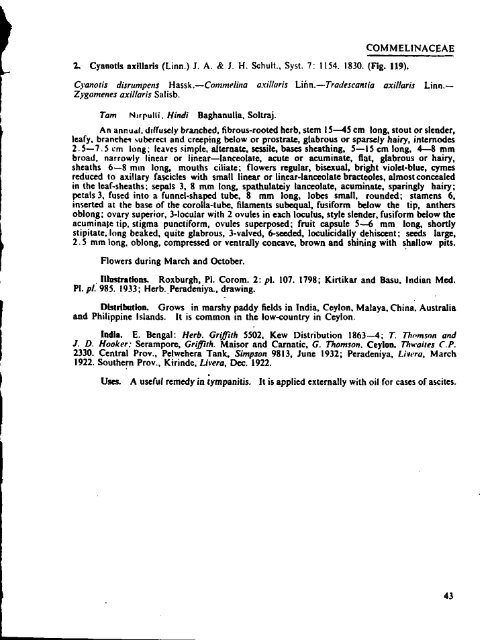,r\/*> - National Science Foundation
,r\/*> - National Science Foundation
,r\/*> - National Science Foundation
Create successful ePaper yourself
Turn your PDF publications into a flip-book with our unique Google optimized e-Paper software.
2. Cyanotis axillaris (Linn.) J. A. & J. H. Schult., Syst. 7: 1154. 1830. (Fig. 119).<br />
COMMELINACEAE<br />
Cyanotis disrumpens Hassk.—Commelina axillaris Linn.—Tradescantia axillaris Linn.—<br />
Zygomenes axillaris Salisb.<br />
7am Nirpulli. Hindi Baghanulla, Soltraj.<br />
An annual, diffusely branched, fibrous-rooted herb, stem 15—45 cm long, stout or slender,<br />
leafy, branches subtreet and creeping below or prostrate, glabrous or sparsely hairy, intemodes<br />
2.5—7.5 cm long; leaves simple, alternate, sessile, bases sheathing, 5—15 cm long, 4—8 mm<br />
broad, narrowly linear or linear—lanceolate, acute or acuminate, flat, glabrous or hairy,<br />
sheaths 6—8 min long, mouths ciliate; flowers regular, bisexual, bright violet-blue, cymes<br />
reduced to axillary fascicles with small linear or linear-lanceolate bracteoles, almost concealed<br />
in the leaf-sheaths; sepals 3, 8 mm long, spathulateiy lanceolate, acuminate, sparingly hairy;<br />
petals 3, fused into a funnel-shaped tube, 8 mm long, lobes small, rounded; stamens 6,<br />
inserted at the base of the corolla-tube, filaments subequal, fusiform below the tip, anthers<br />
oblong; ovary superior, 3-1 ocular with 2 ovules in each loculus, style slender, fusiform below the<br />
acuminate tip, stigma punctiform, ovules superposed; fruit capsule 5—6 mm long, shortly<br />
stipitate. long beaked, quite glabrous, 3-valved, 6-seeded, loculicidally dehiscent; seeds large,<br />
2.5 mm long, oblong, compressed or ventrally concave, brown and shining with shallow pits.<br />
Flowers during March and October.<br />
Illustrations. Roxburgh, PI. Coram. 2: p i 107. 1798; Kirtikar and Basu, Indian Med.<br />
PI. pi. 985. 1933; Herb.,Peradeniya., drawing.<br />
Distribution. Grows in marshy paddy fields in India, Ceylon, Malaya, China, Australia<br />
and Philippine Islands. It is common in the low-country in Ceylon.<br />
India. E. Bengal: Herb. Griffith 5502, Kew Distribution 1863—4; T. Thomson and<br />
J. D. Hooker: Serampore, Griffith. Maisor and Carnatic, G. Thomson. Ceylon. Thwaites CP.<br />
2330. Central Prov., Pelwehera Tank, Simpson 9813, June 1932; Peradeniya, Lhera, March<br />
1922. Southern Prov., Kirindc. Liven, Dec. 1922.<br />
Uses. A useful remedy in tympanitis. It is applied externally with oil for cases of ascites.<br />
43
















